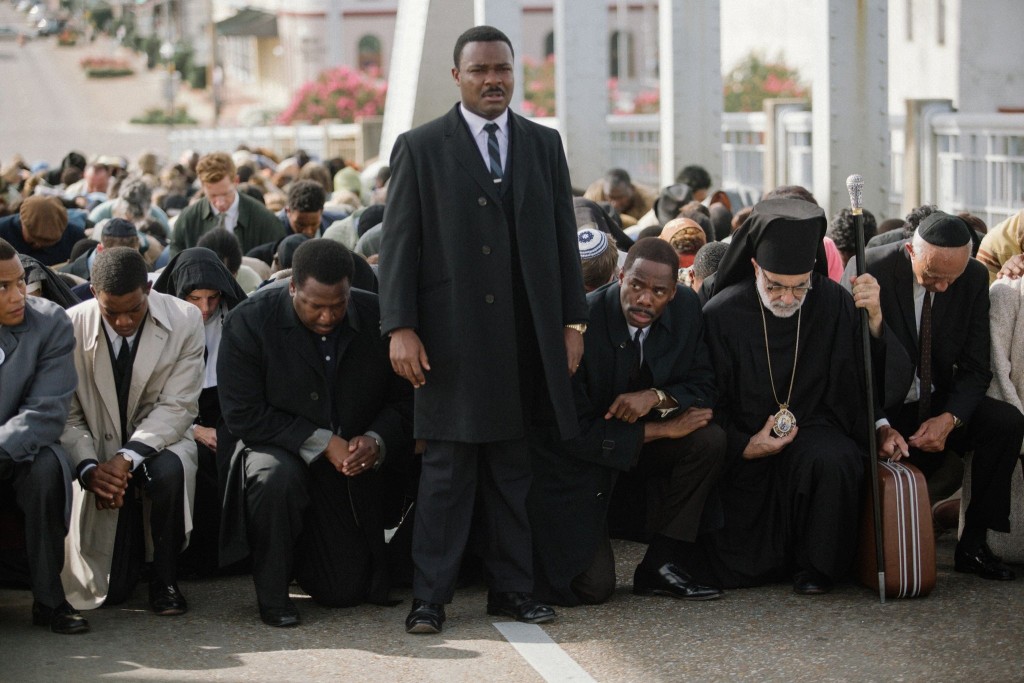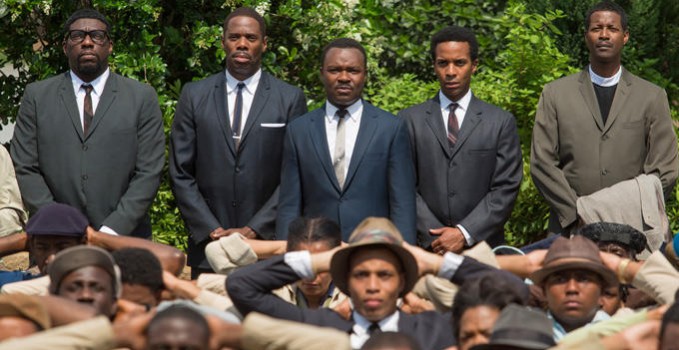 Selma, the new biopic about Rev. Dr. Martin Luther King, Jr., is a great film about one of the greatest Americans who has ever lived. It focuses on King’s efforts to organize the 1965 marches from Selma to Birmingham in Alabama in protest of that state’s suppression of African Americans’ right to vote. The film is a well-staged and emotionally overwhelming recreation of that tumultuous moment in American history. It is also, in ways both stirring and sad, a film full of relevance to American life in 2015. It should be seen by everyone.
Selma, the new biopic about Rev. Dr. Martin Luther King, Jr., is a great film about one of the greatest Americans who has ever lived. It focuses on King’s efforts to organize the 1965 marches from Selma to Birmingham in Alabama in protest of that state’s suppression of African Americans’ right to vote. The film is a well-staged and emotionally overwhelming recreation of that tumultuous moment in American history. It is also, in ways both stirring and sad, a film full of relevance to American life in 2015. It should be seen by everyone.
An American Hero on the Silver Screen At Last
It’s hard to believe, but this is the first Hollywood movie to focus on the life and work of Martin Luther King, Jr. There have been some documentaries and a few different TV productions since King was assassinated in 1968, but no major films until now. Considering the profound changes wrought in the lives of all Americans by Dr. King that seems like a surprising fact, but Hollywood is a risk-averse entity. As Andrew and I discussed in our Oscar reaction piece on Friday, both the film industry and American popular culture have trouble seeing the worthiness of stories that aren’t about white men. That his story finally came to the screen is good news, though, and Selma is a sterling film that was worth the wait.
 DuVernay focuses her film on a stretch of several months in 1964-5 when King worked in the small town of Selma to agitate the local, state, and federal authorities to change their Jim Crow laws that deny Black citizens the right to vote. That specific push is the film’s lens for examining King as a leader, tactician, and man. This is a smart move for a biopic, since the genre is littered with films about important figures which try to tell their entire story and lose their narrative momentum in an endless parade of “then this happened” moments. DuVernay helps the narrative along with a quietly expressive visual style. She uses canted angle close-ups and intricate staging in depth to underscore the inherent drama of King’s speeches or the dynamism of the large-scale protests.
DuVernay focuses her film on a stretch of several months in 1964-5 when King worked in the small town of Selma to agitate the local, state, and federal authorities to change their Jim Crow laws that deny Black citizens the right to vote. That specific push is the film’s lens for examining King as a leader, tactician, and man. This is a smart move for a biopic, since the genre is littered with films about important figures which try to tell their entire story and lose their narrative momentum in an endless parade of “then this happened” moments. DuVernay helps the narrative along with a quietly expressive visual style. She uses canted angle close-ups and intricate staging in depth to underscore the inherent drama of King’s speeches or the dynamism of the large-scale protests.
What Selma hones in on with King is a man who is aware of the enormous burden on his shoulders, but still has to find a way to not only succeed politically but maintain safety and happiness for himself and his family. We see many examples of the genius for political action that Dr. King put into a campaign like the Selma marches and the very real threats that he faced for doing so. The FBI places him under surveillance and tries to bring him down via blackmail about his marital infidelities. Marchers in Selma are viciously attacked every time King leaves town and takes the spotlight with him. These smaller spasms of violence result in a young black man being shot to death by a state trooper and a white preacher being beaten to death in the streets by local youths. The worst paroxysm of violence is the infamous “Bloody Sunday” march that saw non-violent marchers attacked by the police while Dr. King tends to his family back in Atlanta.
A Depressingly Urgent and Timely Message
The recreation of the “Bloody Sunday” police riot is the most gut-wrenching sequence in Selma. DuVernay’s direction is expressive without being distracting through most of the film, but in this moment of physical danger and moral crises she pulls out the stops. We see billy clubs swinging into the heads and stomachs of men and women in their Sunday finest, mounted state troopers riding black men and women down in the streets, and the sickly haze of tear gas trapping both attackers and victims in a shared hellscape. The images have a shocking and visceral power. But it’s impossible to see this recreation of racist police violence from 50 years ago and not think of what happened on the streets of Ferguson last year. The sequence makes us look into the past and find nothing less than a mirror of our contemporary problems.
 Obviously, Ava DuVernay and her collaborators could not have anticipated the grave injustice of Ferguson when they began making this film, but that their work coincided with one of the worst incidents of institutional racism and police violence that America has seen in decades adds a vital dimension to Selma. For all the hard work that Dr. King did in the 50’s and 60’s and the real social and political progress that was made in that time and since, our country retains its deep and cancerous problem of racism. The violence of Ferguson and lack of justice for young men like Trayvon Martin, Mike Brown, Eric Garner, and Tamir Rice is only the tip of the iceberg. Mass incarceration of young African-Americans because of the War on Drugs has replaced Jim Crow laws as a tool of separation and repression. Black citizens are still subject to much more police harassment and suspicion due only to their skin color. The 2008 financial crisis decimated the wealth of minority communities because so many had their wealth directly tied to predatory mortgages. Two years ago the Supreme Court rolled back key provisions of the Voting Rights Act of 1965, the very legislation that the Selma marches were organized to agitate for, because John Roberts and the rest of the conservative Justices decided that institutional racism was over. Life for African-Americans is better now than it was in 1965, but Dr. King would see our country now and find endless issues that need immediate fixes.
Obviously, Ava DuVernay and her collaborators could not have anticipated the grave injustice of Ferguson when they began making this film, but that their work coincided with one of the worst incidents of institutional racism and police violence that America has seen in decades adds a vital dimension to Selma. For all the hard work that Dr. King did in the 50’s and 60’s and the real social and political progress that was made in that time and since, our country retains its deep and cancerous problem of racism. The violence of Ferguson and lack of justice for young men like Trayvon Martin, Mike Brown, Eric Garner, and Tamir Rice is only the tip of the iceberg. Mass incarceration of young African-Americans because of the War on Drugs has replaced Jim Crow laws as a tool of separation and repression. Black citizens are still subject to much more police harassment and suspicion due only to their skin color. The 2008 financial crisis decimated the wealth of minority communities because so many had their wealth directly tied to predatory mortgages. Two years ago the Supreme Court rolled back key provisions of the Voting Rights Act of 1965, the very legislation that the Selma marches were organized to agitate for, because John Roberts and the rest of the conservative Justices decided that institutional racism was over. Life for African-Americans is better now than it was in 1965, but Dr. King would see our country now and find endless issues that need immediate fixes.
That idea, that the great work of justice and equality is far from finished, is a galvanizing and animating one. It brings Selma to electric life in its final moments when David Oyelowo, who inhabits one of the most famous men in American history without falling into empty mimicry, gives a speech on the steps of the Alabama State Capitol. The marchers have walked 50 miles from Selma on their third attempt, after being stopped first by the “Bloody Sunday” violence and then by Dr, King’s own misgivings. Having reached their goal, but still denied a chance to give their petition to segregationist Governor George Wallace, the protesters stand on the Capitol’s steps to hear Dr. King speak. He tells the crowd, and the nation, that “We are not about to turn around. We are on the move now. Yes, we are on the move and no wave of racism can stop us.” It’s at once both dispiriting and inspiring to read those words 50 years later and know they still ring true. It will take a lot of work and require many sacrifices to continue Dr. King’s movement. Selma beautifully shows both the worthiness of that cause and how hard that struggle is to achieve it.
Images via technologytell.com, showbiz411.com, and The New York Times.






I saved this review to read after I actually saw Selma. Great work here. DuVernay handled the material beautifully, and it’s an excellent film.
Thanks!